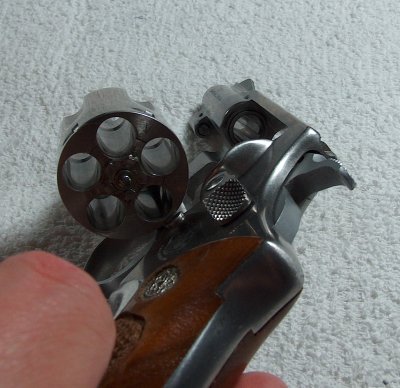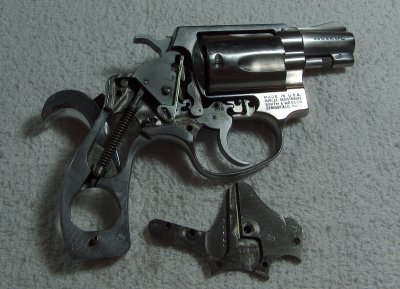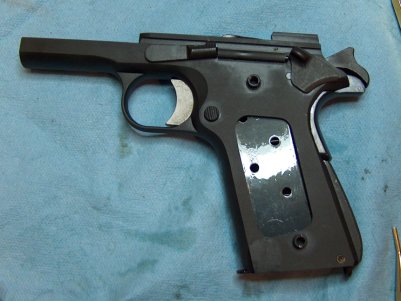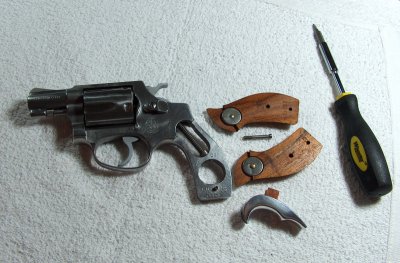Advantages
Disadvantages
Conclusion
More articles
Reliability
The phrase, "six for sure" is almost as irritating as "they all fall to hardball," but it's true. The highest praise that can be brought to bear on a semi-auto is that it has revolver-like reliability. Revolvers don't suffer feed jams or extraction issues and they don't need to balance spring weights to ensure consistent cycling dynamics. Rotating the cylinder doesn't rely on vagaries of momentum, but on the deterministic mechanics of the revolver's lockwork. If a round fails to fire, retrying with a fresh round is the work of a single trigger pull. Feeding and extraction are performed manually while loading and unloading, respectively, instead of being regulated by an automatic mechanism. Every motion a revolver makes is at the behest and under the control of its user. Removing randomness means that a design that works will continue to work without malfunction until something breaks.

Six-- er, five for sure.
Yes, revolvers can break. Praising revolver reliability would be disingenuous if their unique failure cases weren't also acknowledged: Bullets backing out of the crimp can lock up the cylinder, as can carbon buildup on the cylinder face if there's insufficient forcing cone clearance. The ejection rod can unscrew under recoil and lock up the cylinder. Dirty chambers can make ejecting cases difficult. The rough rule of thumb says that failure in a semi-auto can be cleared relatively quickly, but a failure in a revolver takes it out of action until you can get to a workbench. That being said, revolver ammunition malfunctions are entirely preventable given proper testing; parts breakage is about as likely as a semi-auto breaking one of its major components and, like a semi-auto, can be prevented with regular inspection and maintenance.

Runs like lockwork.
For the majority of use cases, revolvers will beat semi-autos when it comes to reliability, but their dominance becomes unquestionable as size shrinks. When semi-auto size decreases, the margins of error bracketing reliable performance dwindle right along with it. Smaller slides cycle faster, leaving less time for the magazine to move the top round into position. Tiny parts require tighter tolerances, and a minute imperfection that would never be noticed on a full-size gun will plague a pocket pistol with failures. Less material means what remains must bear more force, so wear and structural deficiencies appear with alacrity. To be fair, the latter issue is a factor for small revolvers, which must sometimes limit the power of the rounds they shoot to avoid stretching the frame; however, power level limits usually occur well above what most shooters can comfortably control in a tiny revolver. Where mechanical reliability is concerned, the slight size reduction in size required to fit revolver internals into a tiny gun does nothing to compromise their reliability.
Simplicity of Use
It doesn't get much simpler than a revolver. A single-action is conceptually easy: cock hammer, pull trigger; if the hammer's not cocked, the gun won't fire. It's about as manual a process as you can get without stuffing gunpowder and a patch down the bore. Double-action revolvers are even simpler: Pull trigger to fire. No safeties, no magazines, no slide releases, no decockers, no question about whether there's a round chambered. The reliability mentioned above comes into play here, as well, since learning how to clear a jam isn't nearly as crucial for someone with a revolver as it is for his counterpart with a semi-auto. Checking loadout and making the gun safe don't require juggling both the gun and magazine; the cylinder just swings out. Emptying and reloading the gun doesn't beat up cartridges, cause bullet setback, or force one to chase ejected ammo because cartridges drop in and drop out.

The original point-and-click interface.
Add to all of the above a fairly heavy double-action trigger, and you have an almost idiot-proof handgun. Every argument in favor of Glocks, XDs, or Sigs due to their simplicity of use applies doubly well to revolvers. Such simplicity is especially valuable when a gun must be used by someone who lacks the time or enthusiasm required to make the multiple operational modes of a semi-auto second-nature. A DAO revolver is the only intelligent choice when selecting a handgun that may have to be used by someone with no interest in or preference for guns.
Ammo Flexibility
Because revolvers don't use the inertia of a firing round to reset their firing mechanism, the same gun can successfully shoot an enormous variety of loadings. The apex of this property is reached in .357 Magnum revolvers, the most versatile handguns ever created. A .357 Mag revolver can shoot anything from target .38 Special wadcutter rounds at 600 FPS to bear-busting 180-grain hardcast magnums. As long as the bullet clears the barrel and the round doesn't blow up the gun, it's good to go. The same principle applies, albeit with slightly more recoil, to .44 Magnum revolvers: Here, you can choose anything from nuclear magnum loads that leave you signing checks left-handed for a while, to .44 Specials at .45 ACP power levels, to lightweight black-powder .44 Russian rounds designed not to blow up antique guns. The S&W 460 XVR revolver kicks it up a notch by using .45 Colt as its "light" round, .454 Casull as a moderate cartridge, and .460 XVR as its maximum power level. Leaving aside the ludicrous concept of .454 Casull as a "mid-level" cartridge, that's versatility.
Additionally, there's no need to feed ammo, so the bullet shape is irrelevant. The compromises seen in semi-auto hollowpoints simply don't apply, so bullet shape can be chosen on the basis of behavior instead of ease of chambering. This gives revolvers an exotic menagerie of bullets unseen in the semi-auto world: Wadcutters seat flush with the case mouth and are perfectly flat to make nice round holes in the target; conical bullets provide great accuracy because they self-align in the forcing cone; the semi-jacketed hollowpoints introduced decades back provide awesome expansion and penetration, but semi-autos had to wait for technology to catch up before they could share in this performance. And where modern technology has been applied to revolver bullets, it has been done without compromise: You could get drunk taking shots out of Speer's .45 Colt Gold Dots' hollowpoint. (You'd also get lead poisoning, but you wouldn't care because you'd be drunk.)

Variety is also the spice of revolvers.
Then there's power: Revolvers don't need to unlock the barrel after pressure has dropped, so instead of using a tiny sliver of metal to hold thousands of pounds of pressure, they use the entire topstrap of the gun. This permits extensive use of rounds that would shoot a semi-auto to pieces in short order, to say nothing of cartridges clearly designed as drunken pranks; i.e. .454 Casull and the S&W supermagnums. You can even get revolvers chambered in rifle rounds. (I say "you" because there's no way in hell I'm touching one of those off.)
Finally, it's really nice for those who reload to be able to drop all their spent casings in a box instead of grovelling about on the shooting range floor.
Grip Size
All popular semi-autos use the same feeding method: a box magazine inserted into the grip of the gun. Although the grip is the logical location for a magazine, locating the magwell where it is means that magazine function and grip ergonomics become a game of tradoffs: magazine thickness vs. grip thickness; grip angle vs. feed angle; ammo capacity vs. grip length.

Wrapped around the magazine.
Revolvers have no such constraints beyond what the shape of the frame imposes, and there's plenty of leeway there. Grips can run long to provide solid finger purchase, cover the backstrap to avoid recoil, or be pared down to minimal slivers of wood in the interests of reducing bulk. Some designs, such as Ruger's GP-100 and Super Redhawk models, don't even extend the frame to the grip area; instead, there's only a small stud to which grips are fastened, permitting any imaginable design. Revolvers let one choose a handgun on the basis of functional features, secure in the knowledge that if a given wheelgun doesn't feel perfect in the hand, the solution is just a grip swap away. Even if the profusion of grip options can be overwhelming, it's preferable to being locked away from a handgun by ergonomics alone.

Compact grips with Tyler T-Grip adaptor.
email: hidi.projects at gmail.com